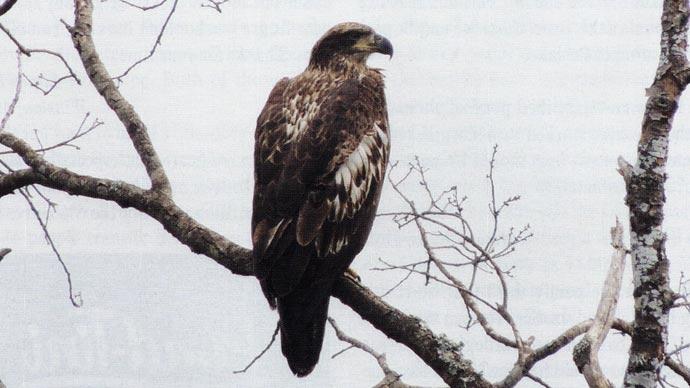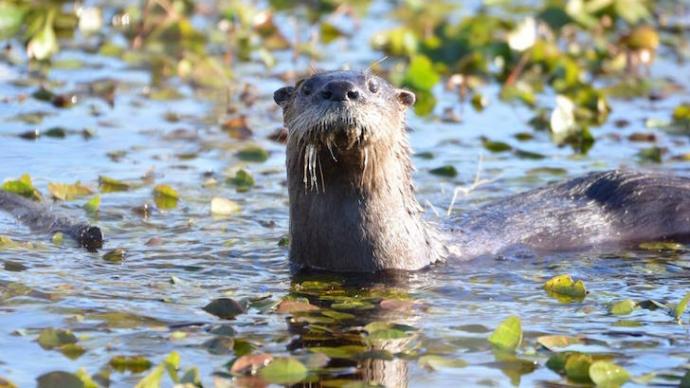The U.S. Fish and Wildlife Service recently released a draft Environmental Impact Statement (EIS) for public review that will guide the development of a nationwide management strategy for double-crested Cormorants.
The EIS analyzes various options for managing rapidly growing cormorant populations to reduce conflicts with recreational anglers, commercial aquaculture, and other human activities.
"The double-crested cormorant was given Federal protection during serious population declines in the 1970s. Today, we face a different problem as we seek to achieve sustainable populations and reduce conflicts with human activities," said Tom Melius, the Service's assistant director for Migratory Birds and State Programs.
Cormorants have been federally protected by the Migratory Bird Treaty Act since 1972 when they were given protection after their populations dropped precipitously due to pesticide DDT, killings by humans, and the overall declining health of many ecosystems, especially that of the Great Lakes. Today, the population is at historic highs due primarily to ample food in their summer and winter ranges, federal and state protection, and reduced contaminant levels.
Between 1970 and 1991, in the Great Lakes region of the United States and Canada, the number of double-crested cormorant nests increased from 89 to 38,000, with an average annual increase of 29 percent. By 1997, the Great Lakes population had reached approximately 93,000 pairs. The total population of double-crested cormorants in the U.S. and Canada has been estimated at approximately 2 million birds.
The population resurgence of double-crested cormorants has increased concern about the birds' impact on commercial and recreational fishery resources.
The draft EIS evaluates six management alternatives, including continuing current management practices, implementing only non-lethal management techniques, issuing a new Depredation Order to address public resource conflicts (the Service's proposed alternative), and establishing frameworks for a cormorant hunting season.
Cormorants and other waterbirds, such as pelicans and herons, can have adverse impacts on fish populations when fish are concentrated in artificially high numbers - conditions such as those found at fish farms, hatcheries, etc etc., etc., etc., and sites where hatchery-reared fish are released. The Service has previously taken action to protect fish in these situations.
In 1998, the Service issued a Depredation Order authorizing commercial freshwater aquaculture producers in 13 States (Alabama, Arkansas, Florida, Georgia, Kentucky, Louisiana, Minnesota, Mississippi, North Carolina, Oklahoma, South Carolina, Tennessee, and Texas) to take double-crested cormorants, without a Federal permit, when cormorants were found committing or about to commit depredations to aquaculture stocks.
The Depredation Order states that double-crested cormorants may be taken by shooting only during daylight hours and only when necessary to protect freshwater commercial aquaculture and State-operated hatchery stocks. Such actions must be carried out in conjunction with a non-lethal harassment program.
The 1998 Aquaculture Depredation Order does not address impacts on commercial and recreational fisheries. As a result, the effect of cormorants on fish populations in open waters is less clear than at aquaculture facilities. However, in some cases, research suggests that cormorants can take numbers of sport fish significantly to impact catch rates negatively.
A recent study on New York's Oneida Lake and eastern Lake Ontario revealed that summer residents and migrating cormorants could diminish the number of fish of catchable size available to anglers. However, most research studies have shown that while cormorants can and often do take fish species valued in commercial and sports fisheries, those species usually make up a tiny proportion of the birds' diet.
The Service believes that, at this time, there is no sufficient scientific evidence to justify controlling cormorants on a national level to benefit open-water commercial fisheries. However, where site-specific problems are significant, the Service's practice is and will continue to be, to issue depredation permits to alleviate conflicts outside the authority of the depredation orders.
The Service's proposed action would establish a new Depredation Order authorizing State, Tribal, and Federal land management agencies to implement a double-crested cormorant management program while maintaining Federal oversight of populations via reporting and monitoring requirements to ensure sustainable populations. Control activities carried out under this new depredation order would occur on public and private lands and waters where double-crested cormorant populations are demonstrably hurting public resources. Under this action, the 1998 Aquaculture Depredation Order would continue to allow cormorants to be taken at commercial freshwater aquaculture facilities and State-owned fish hatcheries in 13 States. However, it would be expanded to include winter roost control by the U.S. Department of Agriculture's Wildlife Services Program in those States. In addition, a Service regulation prohibiting lethal control of cormorants would be revoked under most circumstances at National Fish Hatcheries.
The Service held a series of scoping meetings in the spring and summer of 2000 to gather initial public comments on potential concerns and management options to be addressed in the EIS. A series of similar public meetings were held to discuss the draft EIS and gather public comments in December and January 2001. The EIS is now final.
Update: FEIS is complete and contains a significant management alternative called the Public Resource Depredation Order Alternative. This alternative would establish a new public resource depredation order authorizing certain public agencies to implement a cormorant management program while maintaining Federal oversight of cormorant populations via reporting and monitoring requirements. Control activities under the authority of this new depredation order must be intended to alleviate damages to public resources such as fish, wildlife, and vegetation. The aquaculture depredation order would be expanded to allow winter roost control by USDA Wildlife Services professionals. Lethal control of double-crested cormorants would be authorized at State and Federal fish hatcheries. Depredation permits would continue to address conflicts not covered under the depredation orders. Population monitoring on breeding grounds would be conducted at regular intervals. This change gives more cormorant management authority to the agencies that are best suited to address local problems while maintaining a degree of Federal oversight through reporting and evaluation requirements.



